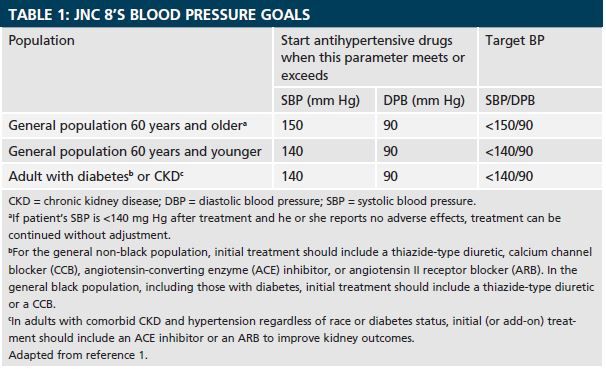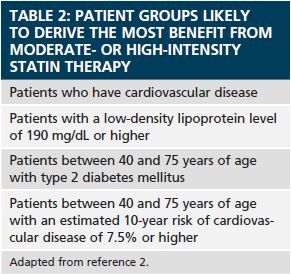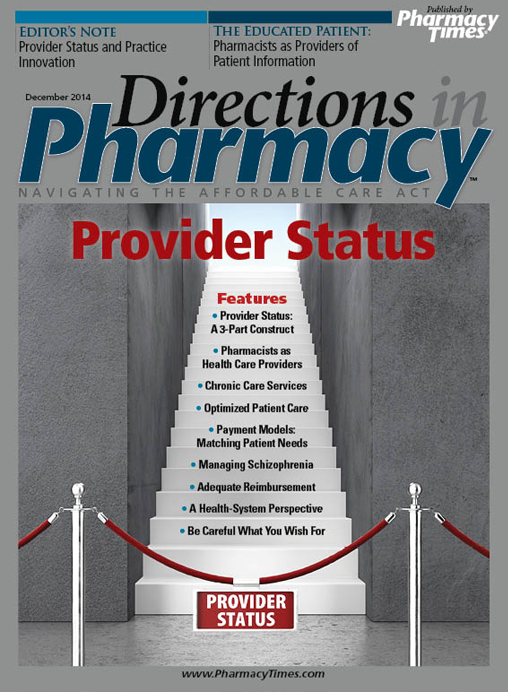Publication
Article
Pharmacy Practice in Focus: Oncology
Blood Pressure and Cholesterol: Embracing New Guidelines
Author(s):
Two new guidelines have many clinicians, newscasters, and patients talking.
Two new guidelines have many clinicians, newscasters, and patients talking.
The first, the 2014 Evidence-Based Guideline for the Management of High Blood Pressure in Adults: Report From the Panel Members Appointed to the Eighth Joint National Committee (JNC 8),1 has made the news for its simplified approach to hypertension (HTN) treatment. The second, the 2013 ACC/AHA Guideline on the Treatment of Blood Cholesterol to Reduce Atherosclerotic Cardiovascular Risk in Adults,2 is a joint effort of the American College of Cardiology (ACC) and the American Heart Association (AHA). Its recommendations—recommendations that have generated some controversy— include new advice for lipid-lowering therapy in people at high risk for cardiovascular disease (CVD). CVD is currently the leading cause of death and disability in the United States.
The Changing Guideline Environment
Clinical practice guidelines debuted in the 1970s and began to proliferate in earnest in the 1990s. In 1990, the Institute of Medicine (IOM) defined guidelines as systematically developed statements to assist practitioner and patient decisions about appropriate health care for specific clinical circumstances.3 Guidelines have evolved and changed over the ensuing 25 years. They have multiplied to the point that clinicians must often choose among many different (and sometimes conflicting) guidelines for certain conditions.4,5
In 2011, the IOM issued a statement indicating, “Because of the large number of clinical practice guidelines available, practitioners and other guideline users find it challenging to determine which guidelines are of high quality.” IOM had been tasked by a 2008 Congressional mandate to develop standards for rigorous, trustworthy clinical practice guidelines. 6 IOM’s findings, Standards for Developing Trustworthy Clinical Practice Guidelines, have helped many organizations refine their processes.7
From the start, many clinicians grumbled about guideline complexity and the trend toward “cookbook medicine,” but as good outcomes from guided practice accumulated, acceptance increased. Additionally, guideline changes have been introduced in response to user feedback, statistician recommendations, and of course, better evidence to answer pressing clinical questions. Ideal guidelines offer concise instructions for diagnostic or screening tests; how to provide medical or surgical services; how long patients should be hospitalized; and clinical practice details.2
Hypertension First
The Joint National Committee on Prevention, Detection, Evaluation, and Treatment of High Blood Pressure (JNC) issued its first recommendations concerning HTN in 1976. The professionally diverse expert panel was convened by the National Heart, Lung, and Blood Institute (NHLBI) and reconvened every 3 to 4 years. NHLBI appointed the 8th JNC panel in 2008 and charged them with answering 3 key questions that reflected clinicians’ most common concerns1:
1) In adults with HTN, does initiating antihypertensive pharmacologic therapy at specific blood pressure (BP) thresholds improve health outcomes? Clinically translated to mean, “At what threshold BP should clinicians prescribe medication?”
2) In adults with HTN, does treatment with antihypertensive pharmacologic therapy to a specified BP goal lead to improvements in health outcomes? Clinically translated to mean, “At what BP do you maintain medication?”
3) In adults with HTN, do various antihypertensive drugs or drug classes differ in comparative benefits and harms on specific health outcomes? Clinically translated to mean, “What antihypertensive medications are preferred to reach specific patients’ goals?”
Following the IOM’s Clinical Guidelines We Can Trust,6 the JNC 8 team based their work on systematic literature review, but emphasized user accessibility in the final design. Concerns with 2003 JNC 7 took center stage because many primary care clinicians found that JNC 7’s BP-lowering recommendations were too aggressive. For elders in particular, treating to the 140/90 mm Hg BP goal frequently resulted in iatrogenic orthostatic hypotension and falls. JNC 7 also recommended lower BPs for patients with diabetes or chronic kidney disease (CKD).8
The important take-home message for pharmacists is that JNC 8 simplifies treatment—most patients have target BPs of 140/90 mm Hg.1 The target BP for elderly is less aggressive (150/90 mm Hg) unless they tolerate treatment to lower levels (see Table 11).

Of note, the guideline review process changed mid-development. NHLBI had endorsed past guidelines before publication in conjunction with professional groups. NHLBI did not endorse JNC 8 in advance, announcing in June 2013 it would stop developing clinical guidelines, including those currently under revision. Their new approach would be to partner with and support select organizations to develop guidelines.9 This controversial decision would have delayed publication of the much-anticipated JNC 8 guideline had not the authors published independently.
JNC 8 Recommends
For JNC 8, external methodology experts reviewed and summarized randomized controlled trials. To be included, HTN studies had to have enrolled adults 18 years or older and be structured for patient-oriented outcomes. Studies that enrolled both men and women and recruited at least 100 participants were essential to reduce the probability of bias. They also targeted studies that focused on geriatrics, certain racial and ethnic groups, and smokers. Some studies included critical subgroups (eg, patients with CKD, coronary artery disease, diabetes, and previous stroke). All recommendations were made based on consensus if possible or a two-thirds majority if consensus couldn’t be achieved.1
JNC 8 states its main objective unmistakably: HTN treatment must attain and maintain the patient’s BP goal. The Online Figure1 describes the process primary care providers should follow. If the patient is adherent to 3 drugs but cannot tolerate additional drugs or HTN continues, the prescriber can use antihypertensives from other classes. If this strategy fails, the prescriber may need to refer the patient to a cardiologist.1
Online Figure

Now, Cholesterol and Statins
Let’s look next at the key recommendations from the November 2013 ACC/ AHA Guideline on the Treatment of Blood Cholesterol to Reduce Atherosclerotic Cardiovascular Risk in Adults.2 This guideline was also developed by an expert panel convened by NHLBI (and completed under its auspices). NHLBI charged the panel to find the best evidence to guide treatment of blood cholesterol. Its impetus was the rising rate of atherosclerotic cardiovascular disease (ASCVD, which includes coronary heart disease, stroke, and peripheral arterial disease). The AHA and ACC assumed joint governance, management, and publication of this guideline, as they had with 4 other prevention guidelines.2
This guideline differs from previous guidelines: instead of establishing specific target levels for low-density lipoprotein cholesterol (LDL-C), it identifies groups in which LDL-lowering appears to be most beneficial.2
Definitions of optimal LDL cholesterol levels are unchanged. The user-friendly recommendations include a flow diagram for easy clinical application. Bright colors correspond to the strength of the recommendations.2
The guideline emphasizes the importance of adopting a heart-healthy lifestyle to prevent and control hyperlipidemia and HMG-CoA reductase inhibitor (statin) therapy as secondary and primary prevention, especially in populations that have yet to develop cardiovascular pathology (see Table 2). Statins are preferred because evidence shows they provide the greatest benefit with few safety issues compared with other cholesterol-lowering drugs. However, other drugs have a cholesterol-lowering role, especially in patients intolerant to statins. The guideline defines moderate-intensity therapy as lowering LDL-C by 30% to <50%. High-intensity therapy lowers LDL-C by >50%.2

Another recommendation is for clinicians to use the new Pooled Cohort Equations to estimate 10-year ASCVD risk in white and black men and women (the calculator is available at http://tinyurl .com/mjfnrn3). The guideline indicates that risk assessment tools can identify patients who may benefit from statins before blood cholesterol becomes an issue. It also describes high-risk groups that may not benefit.2
The guideline also addresses and dismisses other cholesterol lowering approaches (treat to target, lowest is best, and lifetime risk, all explained thoroughly in the document). By discounting these approaches, the panel arrived at the practical, simple-to-implement “treat level of ASCVD risk” to determine the 4 statin benefit groups.2
What will this mean in the pharmacy? Researchers recently determined that if applied as recommended, the new guidelines would increase the number of adult Americans recommended for statin treatment from 43.2 million to 56 million. Most would not have CVD, but rather a calculated CVD risk over the next 10 years of >7.5%. In other words, 87% of men and 53% of women aged 60 to 75 years would take statins, up from 30% and 21% respectively under the old guideline.10 Many experts object to the ASCVD calculator, calling it useful in clinical practice but flawed. In certain circumstances, a change of 1 mm Hg in a patient’s BP could increase the ASCVD lifetime risk estimation from 5% to 36%.11 Statisticians from Brigham and Women’s Hospital in Boston report that the ASCVD calculator overestimates expected (as opposed to observed) risk by 75% to 100%. In doing so, it makes roughly 30 million more Americans eligible for statin therapy.12

End Note
These guidelines don’t address all patients. Patients’ unique needs should drive the target BP or cholesterol level and selection of specific drugs. Clinicians need to involve patients in discussion before initiating antihypertensive or cholesterollowering treatment. Guidelines must not replace sound clinical judgment. Every patient deserves to be treated with his or her unique clinical picture in mind.
Virginia Bartok, RPh, MBA, is a pharmacist whose primary practice was in indigent care. She currently provides case management for several geriatric patients.
References
- James PA, Oparil S, Carter BL, et al. 2014 evidence-based guideline for the management of high blood pressure in adults: report from the panel members appointed to the Eighth Joint National Committee (JNC 8). JAMA. 2014:311(5):507-520.
- Stone NJ, Robinson JG, Lichtenstein AH, et al. 2013 ACC/AHA Cholesterol Guideline Panel. Treatment of blood cholesterol to reduce atherosclerotic cardiovascular disease risk in adults: synopsis of the 2013 American College of Cardiology/American Heart Association cholesterol guideline. Ann Intern Med. 2014;160(5):339-343.
- Field MJ, Lohr KN, eds. Clinical practice guidelines: directions for a new program. Washington, DC: National Academy Press; 1990.
- Kotchen TA. Developing hypertension guidelines: an evolving process. Am J Hypertens. 2014;27(6):765-772.
- Salvo M, White CM. Reconciling multiple hypertension guidelines to promote effective clinical practice. Ann Pharmacother. 2014;48(9):1242-1248 [epub ahead of print].
- Institute of Medicine. Clinical practice guidelines we can trust. Published March 23, 2011. www.iom.edu/Reports/2011/Clinical-Practice-Guidelines-We-Can-Trust.aspx. Accessed July 10, 2014.
- Institute of Medicine. Standards for developing trustworthy clinical practice guidelines. Institute of Medicine website. March 23, 2011. www.iom.edu/Reports/2011/Clinical-Practice-Guidelines-We-Can-Trust/Standards.aspx. Accessed July 10, 2014.
- The Seventh Report of the Joint National Committee on Prevention, Detection, Evaluation, and Treatment of High Blood Pressure (JNC 7). www.nhlbi.nih.gov/guidelines/hypertension/. http://www.nhlbi.nih.gov/files/docs/guidelines/jnc7full.pdf. Accessed July 10, 2014.
- Gibbons GH. NHLBI adopts new collaborative partnership model for clinical practice guidelines development. www.nhlbi.nih.gov/about/directorscorner/messages/nhlbi-adopts-new-collaborative-partnership-model-for-clinical-practice-guidelines-development.html. National Institutes of Health website. June 19, 2013. Accessed July 10, 2014.
- Pencina MJ, Navar-Boggan AM, D'Agostino RB Sr, et al. Application of new cholesterol guidelines to a population-based sample. N Engl J Med. 2014;370:1422-1431.
- Penberthy WT. More on the controversies surrounding implementation of new lipid management guidelines. HCP Live. April 13, 2014. www.hcplive.com/conferences/2014-acp/More-on-the-Controversies-Surrounding-Implementation-of-New-Lipid-Management-Guidelines-. Accessed July 10, 2014.
- Cook NR, Ridker PM. Response to Comment on the reports of over-estimation of ASCVD risk using the 2013 AHA/ACC risk equation. Circ. 2014;129(2):268-269.







